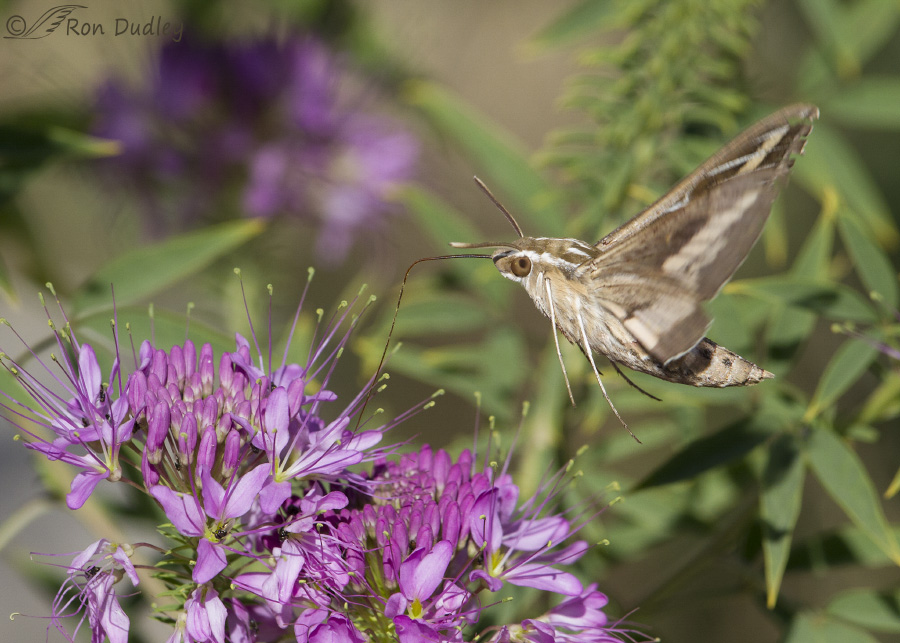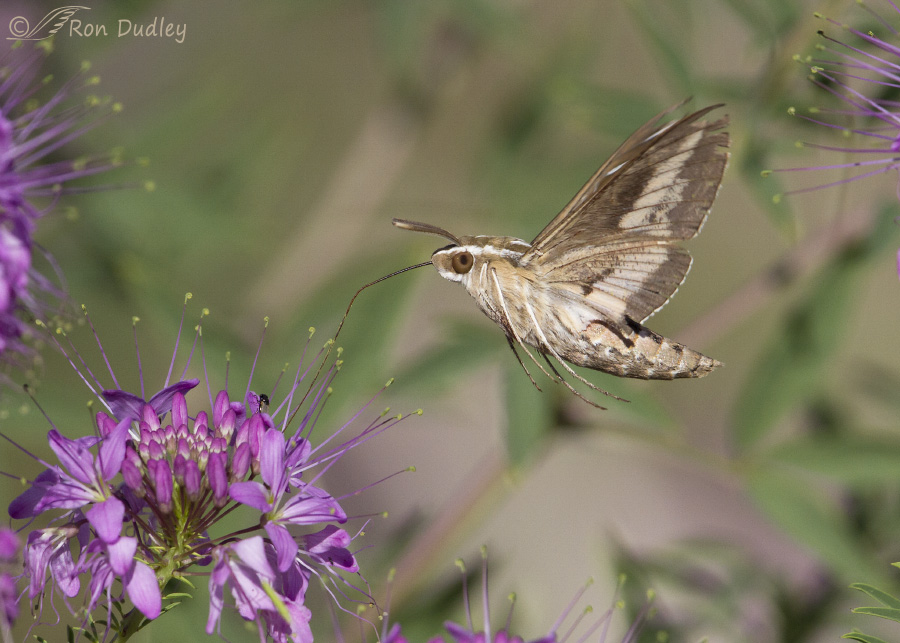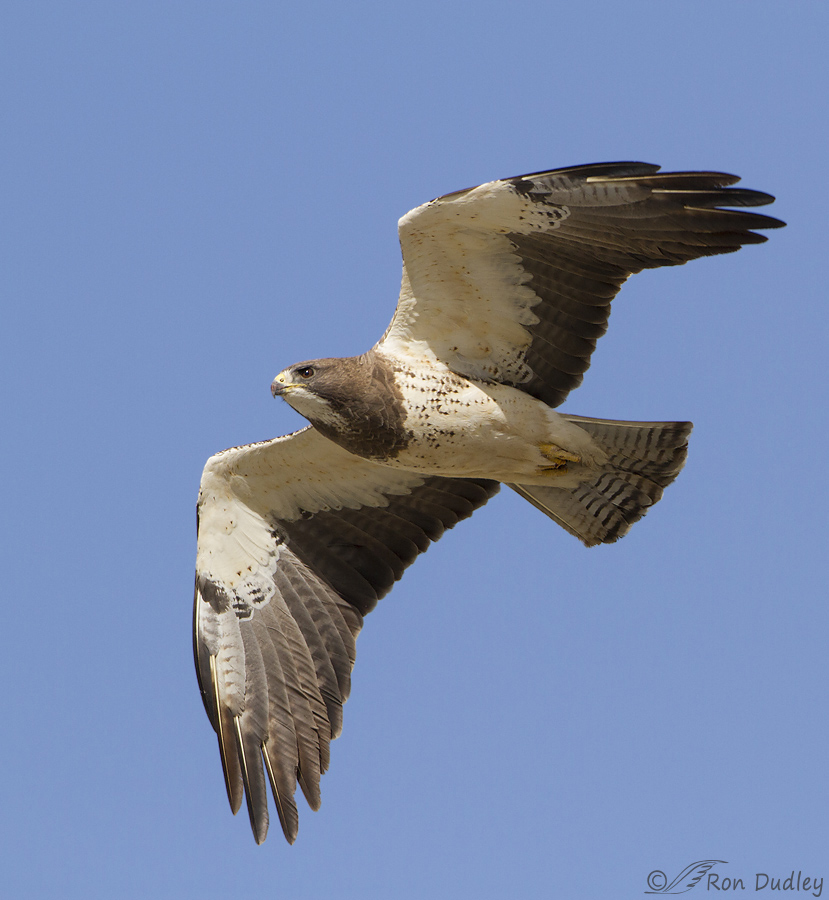The web of life is indeed intertwined – in this case with two of my favorite photographic subjects.
1/1600, f/7.1, ISO 640, Canon 7D, Canon EF 500mm f/4L IS II USM + EF 1.4 III Extender
I’ve been photographing Swainson’s Hawks for over ten years now but it was only three summers ago that I “discovered” the sphinx moth. Getting flight shots of insects had always seemed like a pipe dream to me because of the inherent difficulties of doing so with a long lens. But because of the physical and behavioral similarities these large insects share with hummingbirds (they’re also called “hummingbird moths” and for good reason) I found them to be a challenging but obtainable quarry.
- Note: there are several species of sphinx moths including the familiar tomato hornworm that matures into a hawk moth/sphinx moth. This is the White-lined Sphinx Moth.
1/4000, f/7.1, ISO 640, Canon 7D, Canon EF 500mm f/4L IS II USM + EF 1.4 III Extender
They were feeding on nectar of the showy blooms of Rocky Mountain Bee Plant on Antelope Island. They’d flit from flower cluster to flower cluster looking for individual flowers to dip their ridiculously long proboscis into so they could suck up the nutritious nectar.
They were very difficult to photograph in flight. I had a much higher percentage of both blurry images and “air shots” (where the moth had already left the frame when I clicked the shutter) than I typically do with any species of bird but occasionally I’d get lucky. And when I did I often loved the photos – how can you go wrong with beautiful flowers in the setting and an interesting and unique subject? Among other things I love their eyes!
But until recently I had no inkling of the strong ecological link between sphinx moths and migrating Swainson’s Hawks.
1/2000, f/6.3, ISO 500, Canon 7D, Canon EF 500mm f/4L IS USM + EF 1.4 III Extender, not baited, set up or called in
Swainson’s Hawks winter in Argentina and migrate to North America for the breeding season and something has to fuel that incredible journey. It turns out that sphinx moth caterpillars are often a huge part of their diet during the trip.
No doubt readers have heard of the “superbloom” of wildflowers this spring in southern California after years of extended drought followed by a wet winter and spring. In places like Anza-Borrego Desert State Park in eastern San Diego County there’s been a corresponding explosion of sphinx moths which many, many thousands of Swainson’s Hawks are taking advantage of as a food source to fuel their trip further north as far as Canada.
On some single days this spring as many as 1,673 Swainson’s Hawks using Anza-Borrego as a staging area during migration have been tallied by human hawk counters and they’re feeding primarily on the super-abundant sphinx moth caterpillars. Flower lovers, photographers and birders flocked to the area to witness the spectacle and I think that’s a good thing (as long as I don’t have to join the crowds) because it just inspires more interest in nature.
- More information and a video on the phenomenon at Anza-Borrego can be found here if you have the interest.
I’ve mentioned previously that so far this has been a banner year for migrating Swainson’s Hawks in my area and I’m directly in their path as they migrate north from southern California. I love the fact that sphinx moths have contributed significantly to the success of the hawks I’m seeing.
Ron





I love Anza Borrego, even though I haven’t seen it since a botany field trip in 1965 or 1966. That was another banner year for flowers there. It’s very interesting to learn that the Swainson’s Hawks eat sphinx moth caterpillars. I’m guessing that there are not only enough caterpillars to feed the hawks well, but also enough to keep the sphinx moth species going. These hawks and the white-lined sphinx are also two of my favorite critters.
Sensational shots Ron!
Charlotte
Ron, maybe one March you will make it to Anza Borrego Desert State Park to watch the Swainson’s migration through Southern California. It has become very popular with bird watchers everywhere. There are thousands of white-lined sphinx moths caterpillars for the hawks to eat particularly when we have a super bloom like this past season. You can sign up for the hawk report by following Borrego Valley Hawk Watch blog at http://borregohawkwatch.blogspot.com/2017/ if you feel so inclined. Take a look at 2017 totals, 11,690. Thanks for your posts! I really enjoy them.
Nice pictures!
Saw many sphinx moths in in joshua tree this spring. And one huge one in the mountains last summer.
Funny how when you really love the place you’re from you just don’t care as much when you see a list of other places, or animals found there! All you can see is the name of your home state. At least that’s how it goes for me.
Levi
Levi, I’ve heard two other reports of large numbers of sphinx moths at Joshua Tree this spring since I made this post. They must be having a good year down south in many areas and that’s good news.
Ron, amazingly so, we saw a Sphinx Moth in our driveway yesterday. We live in the Salt Lake area and don’t know if this is common or rare. Soon we should see the Swainson’s Hawk…I hope!!
Our hummingbirds have arrived and drinking the nectar. I’ll have to look out for a Sphinx Moth.
Thanks for the great information and beautiful photos.
Alice, I’m quite surprised to hear about your sphinx moth in this area this early in the season but I’m really no expert on them so perhaps it isn’t unusual. Thanks for that report!
Sadly the video won’t play for me. I am a big, big fan of moffs. How amazing to learn about the interaction between sphynx moths and the Swainsons.
Yet another reason for us not to ‘fiddle’ with nature. Removing/reducing one species OFTEN has effects we haven’t considered.
Another beautiful and informative post. Win/win.
Sorry you can’t play the clip, EC. And yes, we do far too much damn fiddling! Thank you.
Yeah, we call that “managing.” What hubris!
Hubris is an understatement. Sigh. And hiss and spit.
Oh just WOW! I’d just echo what everybody else has said. Let’s just leave it at magnificent shots! Again, Oh WOW!
Thank you, Laura.
Like Dominique, I too saw the superbloom on the Anza Borrego in the mid-80’s, and it remains in my memory as a life-time “high” of beauty . Now to understand through your blog that it
was probably a great high for all the wildlife that benefit from abundant rain is great to know…….thanks for all the links you provide beyond your terrific images–I look forward to seeing
your work first thing EVERY MORNING–starts the day off great.
Thanks for that nice feedback on my blog, Kris. It gave me a much-needed lift this morning.
Thanks! We were in Joshua Tree Nat’l Park a few weeks ago and were astonished at the number of White-line Sphinx Moth larvae crawling everywhere. I’m delighted to see your terrific shots of the adults today.
It’s good to hear that, Buff – thanks for reporting it.
I often find myself very attracted to something, or someplace, get excited about going to see it or do it, get myself all ready to go— then reality sets in! I realize that a lot of other people are going to go, too…it will draw a crowd. Immediately the plug is pulled on my enthusiasm–down the drain it goes…..and I don’t go…I’ve missed so many things this way..Bummer!!!
Patty, that’s one of the reasons I don’t reveal bird locations unless they’re already well-known. Selfish of me perhaps but that’s just the way it is and will remain.
We had a couple of dark purple Butterfly bushes that butterflies and sphinx moths loved– until a cold Maine winter zapped all three of them. Hummingbirds also visited these bushes, but “Hawk Moths” (Sphinx Moths) were the most frequent visitors…there were always at least three on it, usually several more…I had no idea about their link to the Swainsons…The world of nature is endlessly fascinating! How anyone cannot love, respect, and be enchanted by “nature” and science is truly beyond me!
Hmmm, I should consider planting some but I hear they’re now classified as an invasive…
They are invasive in many regions, but in some, like Maine, they are not…Depends on where you live. For example, Morning Glories are considered invasive in Wounded Knee, SD. Monarda. Cleome and Echinacea might be better bets…check with your Ag agent…
Ron, here in VT I plant Buddleja, Butterfly Bush every year, have to treat it as an annual! However, my brother-in-law in southern MA has one that comes back each year. It is absolutely great for butterflies and Sphinx moths.
Thanks for the tips, Patty and Dick.
Interesting Ron, and great photos. I knew that Swainson’s Hawks ate grasshoppers and did not realize about the Sphinx moth caterpillars. Once I had an amazing Swainson’s Hawk observation in SW New Mexico. I photographed a migrating swarm of 3000 estimated hawks who had stopped enroute to feast on a grasshopper plague. The funny part was when I reported it to eBird, they did not believe me since there had never been a record of any Swainson’s Hawk in that county… the photos convinced them
Neat observation in New Mexico, Ed. I once saw a kettle of Swainson’s in the Centennial Valley of perhaps a hundred or so birds but I’ve never seen anywhere near the number you saw. That was amazing.
Another fascinating post with great photos! And I agree with you about the crowds!
Joanne – I haven’t been to SoCal for decades for exactly that reason!
Wow! It looks like you got catch light in the moth’s eye in both shots — very cool. I had no idea about the connection between them and the hawks. Thanks for another fascinating lesson, Teech.
I can’t believe I missed that article. I read the LA Times every day (after I come here, of course!). I gotta start looking at the Travel section.
Ha, I think you’re right about the catch light, Marty. I hadn’t even noticed, which is highly unusual for me.
“I had a much higher percentage of both blurry images and “air shots””
Man that is SO true when trying to get shots with just a hand held macro lens of our Hummingbird and Snowberry Clearwing Moths. I love your Sphinx moths and the flowers, wish we could grow the plant in the East.
Another lesson learned. I wasn’t aware that the Swainson’s was so dependent on your Sphinx moth. Obviously makes sense!
Thanks for sharing and educating us!!
It was an education for me too, Dick – new information to me until a few days ago.
I was just talking to a women yesterday at the WRCNU booth about this (we had our Swainson’s Hawk, Darth with us). She was from an area in California where the Swainson’s stop to eat the Sphinx moth before migrating. She said the hawks really fatten up on the moth, it was a very important source of food for them.
Thanks for that confirmation, April.
Thank you once again for an interesting story and great photos.
I witnessed a “superbloom” in Anza-Borrego back in the mid-80s and it was a truly memorable experience.
It reminds me that I should get out my old kodachromes and maybe scan a few !
Dominique, Growing up I used to live in San Diego County but I don’t think my family ever visited Anza-Borrego.
Unfortunately sphinx moths aren’t very abundant here and the sighting of one causes lots of excitement among fellow photographers .. I have only seen 2 in as many years .. I love photographing them .. I can’t find information on they’re life cycle so I spot them same time horn worms are in garden sooo ??? When do they lay they’re eggs ? When do they hatch ?
They’re usually not very common here either, Marina. I’ve had a difficult time finding them the last couple of years.
I’m afraid I don’t know the answers to your questions but I imagine it could be googled..
Thank you so much Ron, this is good to know exactly what she is. I gasped when I saw your pic, because it was like looking at her as she flies above my head. Every day my heart skips a beat seeing this magnificent hawk. She seems like family to me now since she comes in so close to me daily. And the dangling alive wiggling snakes clasped in her talons are REAL close to my head. Some day one may land in my lap! That’s ok tho, I love snakes too, every creature has it’s place in life.
Ron this is fabulous, thank you! I see the sphinx moth often and it is truly beautiful to me, you captured it perfectly. Also I cannot thank you enough, the Swainson’s Hawk, that IS my hawk that dips down so low toward me that I can see her feathers closely as she glides over my head. I love it when I say “hello” to her and she turns her beautiful head to me and looks at me. It is magical to me, how this bird dips down and swoops in so close to me. Red-tailed Hawks don’t do that, other than the one who let me walk to him on the fence and take 40 pics. The Swainson’s is incredible how she allows me to see her so closely. And the male too. They were here last year also and I just adore them. When they sail above me it is purely magical….thanks again, due to your underside shot of the hawk I could identify it very well. Now back outside for me to wait for them to sail over again….
Barby, I’m delighted that this photo helped you to finally ID “your” hawk. FYI, this is an adult light morph Swainson’s but the intermediate and dark morphs look significantly different.
Interesting! Sphinx moths are neat insects. We get a few here occasionally. The link between them and the Swainson’s Hawks is amazing – the “web of life” is endlessly fascinating. Beautiful shots, Ron.
Sphinx moths are neat insects. We get a few here occasionally. The link between them and the Swainson’s Hawks is amazing – the “web of life” is endlessly fascinating. Beautiful shots, Ron.
Judy, I wish I had opportunities with sphinx moths more often around here. They seem to be most easily found feeding on bee plant but finding those plants in an accessible location has been a problem from year to year.